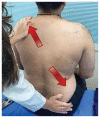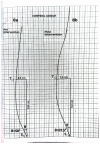Effectiveness of Three-Dimensional Myofascial Release on Lumbar Lordosis in Individuals with Asymptomatic Hyperlordosis: A Placebo Randomized Controlled Trial
- PMID: 38873188
- PMCID: PMC11131939
- DOI: 10.3822/ijtmb.v17i2.957
Effectiveness of Three-Dimensional Myofascial Release on Lumbar Lordosis in Individuals with Asymptomatic Hyperlordosis: A Placebo Randomized Controlled Trial
Abstract
Background: Lumbar hyperlordosis is the most prevalent musculoskeletal postural deformity. Maintenance of normal limits of lumbar lordosis is necessary for obtaining an ideal posture. Literature suggests that poor posture results in fascial restriction in which the fascia reorganizes in response to tension. Gross myofascial release (MFR) combined with posterior pelvic tilting exercises proved to be beneficial in improving the lumbar range of motion. Three-dimensional (3D) MFR is a novel approach toward reducing fascial restrictions. However, the literature determining the effects of 3D MFR is still emerging.
Aim: To determine the effect of 3D MFR on a lumbar lordosis angle and lumbar range of motion, in individuals with asymptomatic hyperlordosis.
Method: Participants (n = 30) with hyperlordosis were randomly assigned to either the experimental group receiving 3D MFR (n = 15) or the control group (n = 15) that received sham 3D MFR for six sessions (3 alternate days for 2 weeks). The outcomes were assessed at day 1 and day 6. Lumbar range of motion was assessed using modified-modified Schober's test and the lumbar lordosis angle was measured using x-ray and flexicurve.
Results: There was significant decrease (p = 0.0001) in the lumbar lordosis angle, increase in the lumbar flexion (p = 0.0001), and decrease in the extension (p = 0.0011) range of motion in the experimental group when compared to the control group.
Conclusion: Lumbar lordosis decreased and the lumbar range of motion increased in the experimental group only with 3D MFR and not with sham 3D MFR. Hence, 3D MFR is an effective method in the correction of lumbar hyperlordosis and improving the lumbar range.Clinical Trial Registry of India (CTRI) trial number CTRI/2023/03/050340.
Keywords: Lumbar lordosis; correction; fascia; posture.
Copyright© The Author(s) 2024. Published by the Massage Therapy Foundation.
Conflict of interest statement
CONFLICT OF INTEREST NOTIFICATION: The authors declare there are no conflicts of interest.
Figures








Similar articles
-
Comparison of the effects of core stability and whole-body electromyostimulation exercises on lumbar lordosis angle and dynamic balance of sedentary people with hyperlordosis: a randomized controlled trial.BMC Sports Sci Med Rehabil. 2024 Apr 23;16(1):91. doi: 10.1186/s13102-024-00879-5. BMC Sports Sci Med Rehabil. 2024. PMID: 38654368 Free PMC article.
-
Investigating the Effects of Percussion Therapy on Ultrasonography-Diagnosed Thoracolumbar Fascia on Trigger Points and Hyperlordosis in Low Back Pain: A Placebo-Controlled Trial.Altern Ther Health Med. 2024 Sep;30(9):16-22. Altern Ther Health Med. 2024. PMID: 39212513 Clinical Trial.
-
Effects of diaphragmatic and iliopsoas myofascial release in patients with chronic low back pain: A randomized controlled study.J Bodyw Mov Ther. 2023 Jan;33:120-127. doi: 10.1016/j.jbmt.2022.09.029. Epub 2022 Sep 29. J Bodyw Mov Ther. 2023. PMID: 36775506 Clinical Trial.
-
Effects of Isolated Myofascial Release Therapy in Patients with Chronic Low Back Pain-A Systematic Review.J Clin Med. 2023 Sep 23;12(19):6143. doi: 10.3390/jcm12196143. J Clin Med. 2023. PMID: 37834787 Free PMC article. Review.
-
Psychometric Properties of the iHandy Level Smartphone Application for Measuring Lumbar Spine Range of Motion and Lordosis: A Systematic Review of the Literature.J Sport Rehabil. 2020 Mar 1;29(3):352-359. doi: 10.1123/jsr.2018-0354. J Sport Rehabil. 2020. PMID: 30860415
References
-
- Briggs AM, Greig AM, Wark JD, Fazzalari NL, Bennell KL. A review of anatomical and mechanical factors affecting vertebral body integrity. Int J Med Sci. 2004;1(3):170–180. doi: 10.7150/ijms.1.170. doi: 10.7150/ijms.1.170. - DOI - DOI - PMC - PubMed
- Briggs AM, Greig AM, Wark JD, Fazzalari NL, Bennell KL. A review of anatomical and mechanical factors affecting vertebral body integrity. Int J Med Sci. 2004;1(3):170–180. 10.7150/ijms.1.170 - DOI
-
- Roussouly P, Gollogly S, Berthonnaud E, Dimnet J. Classification of the normal variation in the sagittal alignment of the human lumbar spine and pelvis in the standing position. Spine. 2005;30(3):346–353. doi: 10.1097/01.brs.0000152379.54463.65. - DOI - PubMed
- Roussouly P, Gollogly S, Berthonnaud E, Dimnet J. Classification of the normal variation in the sagittal alignment of the human lumbar spine and pelvis in the standing position. Spine. 2005;30(3):346–353.
-
- Guimond S, Massrieh W. Intricate correlation between body posture, personality trait and incidence of body pain: a cross-referential study report. PLoS One. 2012;7:e37450. doi: 10.1371/journal.pone.0037450. - DOI - PMC - PubMed
- Guimond S, Massrieh W. Intricate correlation between body posture, personality trait and incidence of body pain: a cross-referential study report. PLoS One. 2012;7:e37450.
-
- Shirazi-Adl A, Parnianpour M. Effect of changes in lordosis on mechanics of the lumbar spine-lumbar curvature in lifting. J Spinal Disord. 1999;12(5):436–447. doi: 10.1097/00002517-199910000-00015. - DOI - PubMed
- Shirazi-Adl A, Parnianpour M. Effect of changes in lordosis on mechanics of the lumbar spine-lumbar curvature in lifting. J Spinal Disord. 1999;12(5):436–447.
LinkOut - more resources
Full Text Sources
